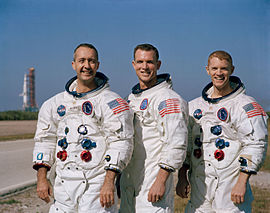
Back Apollo 9 Afrikaans أبولو 9 Arabic Аполо 9 Bulgarian Apollo 9 Catalan Apollo 9 Czech Apollo 9 Welsh Apollo 9 Danish Apollo 9 German Απόλλων 9 Greek Apollo 9 Esperanto
 | |
| Mission type | Crewed Earth orbital CSM/LM flight (D) |
|---|---|
| Operator | NASA |
| COSPAR ID | |
| SATCAT no. |
|
| Mission duration | 10 days, 1 hour, 54 seconds[2] |
| Orbits completed | 151[3] |
| Spacecraft properties | |
| Spacecraft |
|
| Manufacturer |
|
| Launch mass | 95,231 lb (43,196 kg)[4] |
| Landing mass | 11,094 lb (5,032 kg) |
| Crew | |
| Crew size | 3 |
| Members | |
| Callsign |
|
| EVAs | 1 |
| EVA duration | 1 hour, 17 seconds |
| Start of mission | |
| Launch date | March 3, 1969, 16:00:00 UTC |
| Rocket | Saturn V SA-504 |
| Launch site | Kennedy, LC-39A |
| End of mission | |
| Recovered by | USS Guadalcanal |
| Decay date | October 23, 1981 (LM ascent stage) |
| Landing date | March 13, 1969, 17:00:54 UTC |
| Landing site | North Atlantic Ocean (23°15′N 67°56′W / 23.250°N 67.933°W) |
| Orbital parameters | |
| Reference system | Geocentric |
| Regime | Low Earth orbit |
| Perigee altitude | 204 km (110 nmi; 127 mi) |
| Apogee altitude | 497 km (268 nmi; 309 mi) |
| Inclination | 33.8° |
| Period | 91.55 minutes |
| Epoch | March 5, 1969[5] |
| Docking with LM | |
| Docking date | March 3, 1969, 19:01:59 UTC |
| Undocking date | March 7, 1969, 12:39:06 UTC |
| Docking with LM ascent stage | |
| Docking date | March 7, 1969, 19:02:26 UTC |
| Undocking date | March 7, 1969, 21:22:45 UTC |

 Left to right: McDivitt, Scott, Schweickart | |
Apollo 9 (March 3–13, 1969) was the third human spaceflight in NASA's Apollo program. Flown in low Earth orbit, it was the second crewed Apollo mission that the United States launched via a Saturn V rocket, and was the first flight of the full Apollo spacecraft: the command and service module (CSM) with the Lunar Module (LM). The mission was flown to qualify the LM for lunar orbit operations in preparation for the first Moon landing by demonstrating its descent and ascent propulsion systems, showing that its crew could fly it independently, then rendezvous and dock with the CSM again, as would be required for the first crewed lunar landing. Other objectives of the flight included firing the LM descent engine to propel the spacecraft stack as a backup mode (as would be required on the Apollo 13 mission), and use of the portable life support system backpack outside the LM cabin.
The three-man crew consisted of Commander James McDivitt, Command Module Pilot David Scott, and Lunar Module Pilot Rusty Schweickart. During the ten-day mission, they tested systems and procedures critical to landing on the Moon, including the LM engines, backpack life support systems, navigation systems and docking maneuvers.
After launching on March 3, 1969, the crew performed the first crewed flight of a lunar module, the first docking and extraction of the same, one two-person spacewalk (EVA), and the second docking of two crewed spacecraft—two months after the Soviets performed a spacewalk crew transfer between Soyuz 4 and Soyuz 5. The mission concluded on March 13 and was a complete success. It proved the LM worthy of crewed spaceflight, setting the stage for the dress rehearsal for the lunar landing, Apollo 10, before the ultimate goal, landing on the Moon.
- ^ a b c Orloff & Harland, p. 227.
- ^ Cite error: The named reference
nasa ninewas invoked but never defined (see the help page). - ^ Orloff & Harland, p. 230.
- ^ Ezell 1988, Table 2-37: "Apollo 9 Characteristics".
- ^ McDowell, Jonathan. "SATCAT". Jonathan's Space Pages. Retrieved March 23, 2014.